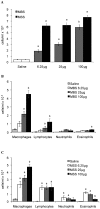Immunogenic properties of archaeal species found in bioaerosols
- PMID: 21858070
- PMCID: PMC3155538
- DOI: 10.1371/journal.pone.0023326
Immunogenic properties of archaeal species found in bioaerosols
Abstract
The etiology of bioaerosol-related pulmonary diseases remains poorly understood. Recently, archaea emerged as prominent airborne components of agricultural environments, but the consequences of airway exposure to archaea remain unknown. Since subcomponents of archaea can be immunogenic, we used a murine model to study the pulmonary immune responses to two archaeal species found in agricultural facilities: Methanobrevibacter smithii (MBS) and Methanosphaera stadtmanae (MSS). Mice were administered intranasally with 6.25, 25 or 100 µg of MBS or MSS, once daily, 3 days a week, for 3 weeks. MSS induced more severe histopathological alterations than MBS with perivascular accumulation of granulocytes, pronounced thickening of the alveolar septa, alveolar macrophages accumulation and increased perivascular mononucleated cell accumulation. Analyses of bronchoalveolar lavage fluids revealed up to 3 times greater leukocyte accumulation with MSS compared to MBS. Instillation of 100 µg of MBS or MSS caused predominant accumulation of monocyte/macrophages (4.5×10(5) and 4.8×10(5) cells/ml respectively) followed by CD4(+) T cells (1.38×10(5) and 1.94×10(5) cells/ml respectively), B cells (0.73×10(5) and 1.28×10(5) cells/ml respectively), and CD8(+) T cells (0.20×10(5) and 0.31×10(5) cells/ml respectively) in the airways. Both archaeal species induced similar titers of antigen-specific IgGs in plasma. MSS but not MBS caused an accumulation of eosinophils and neutrophils in the lungs, which surprisingly, correlated inversely with the size of the inoculum. Stronger immunogenicity of MSS was confirmed by a 3 fold higher accumulation of myeloid dendritic cells in the airways, compared to MBS. Thus, the dose and species of archaea determine the magnitude and nature of the pulmonary immune response. This is the first report of an immunomodulatory role of archaeal species found in bioaerosols.
Conflict of interest statement
Figures






References
-
- Cormier Y, Israel-Assayag E, Racine G, Duchaine C. Farming practices and the respiratory health risks of swine confinement buildings. Eur Respir J. 2000;15:560–565. - PubMed
-
- Cormier Y, Merlaux A, Duchaine C. Respiratory health impact of working in sawmills in eastern Canada. Arch Environ Health. 2000;55:424–430. - PubMed
-
- Gilbert Y, Veillette M, Meriaux A, Lavoie J, Cormier Y, et al. Metalworking fluid-related aerosols in machining plants. J Occup Environ Hyg. 2010;7:280–289. - PubMed
-
- Dutil S, Meriaux A, de Latremoille MC, Lazure L, Barbeau J, et al. Measurement of airborne bacteria and endotoxin generated during dental cleaning. J Occup Environ Hyg. 2009;6:121–130. - PubMed
-
- ATS. Respiratory Health Hazards in Agriculture. American Thoracic Society Medical Section of the American Lung Association; 1998. pp. S1–S76.
Publication types
MeSH terms
Substances
LinkOut - more resources
Full Text Sources
Research Materials

